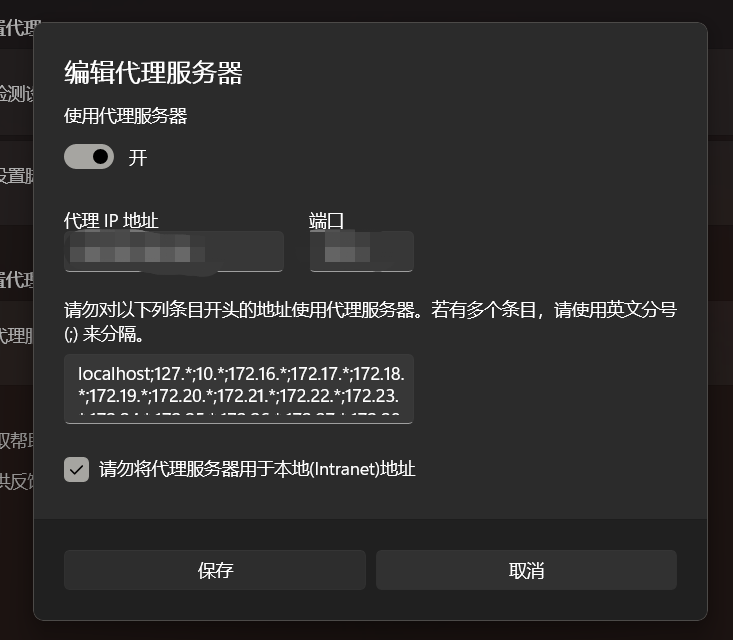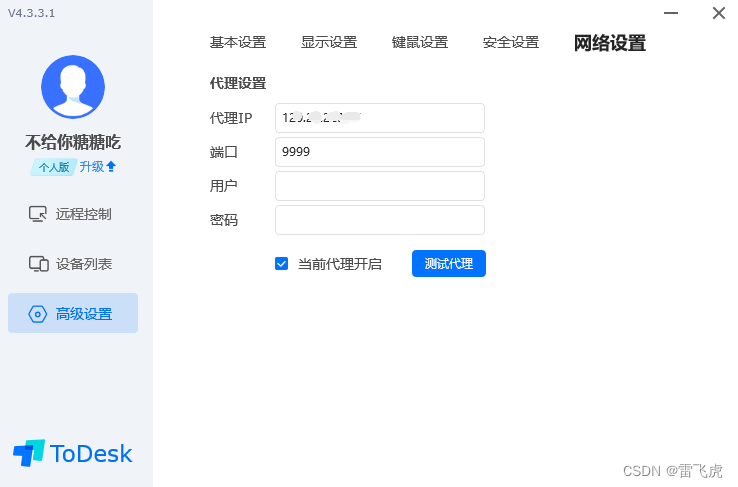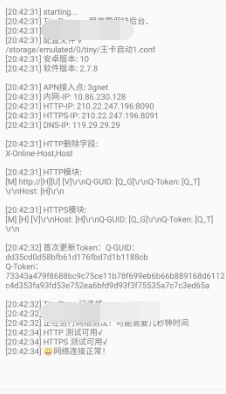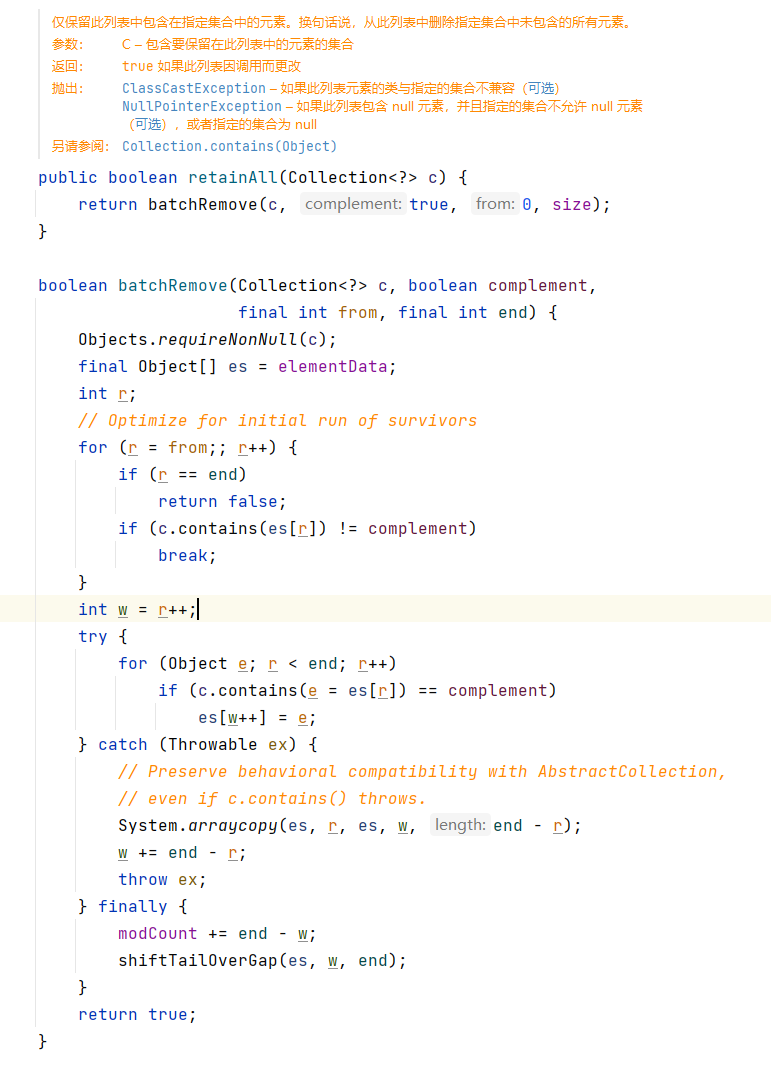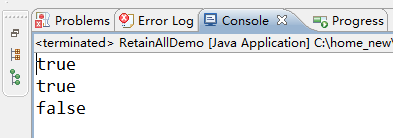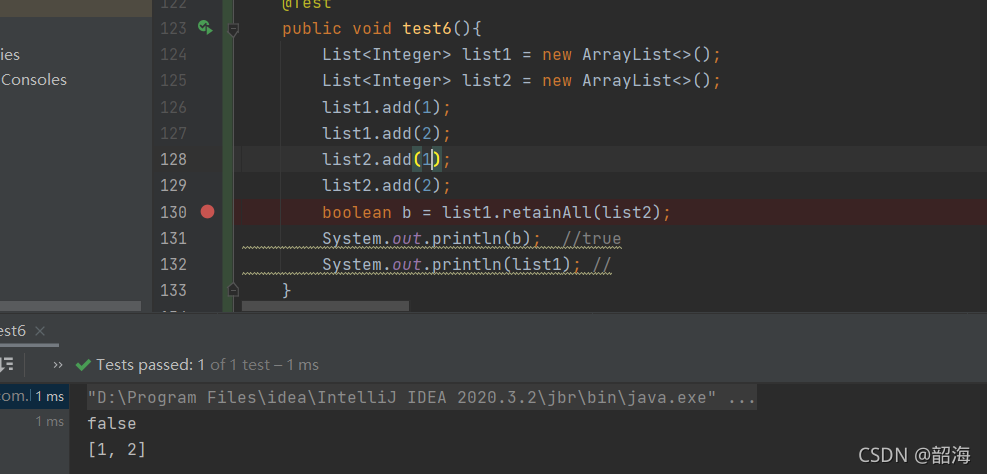安装
# centos
sudo yum install tinyproxy
# ubuntu
sudo apt install tinyproxy
配置
vim /etc/tinyproxy/tinyproxy.conf
需要修改的是:
# 注释掉这一行
# Allow 127.0.0.1
# 修改端口号
Port 8787
- Allow 是允许访问的主机IP,不写就是允许所有主机访问
- Port 是代理访问端口号
启动/停止/查看状态/重启命令
systemctl start tinyproxy.service
systemctl stop tinyproxy.service
systemctl status tinyproxy.service
systemctl restart tinyproxy.service
查看日志
tailf /var/log/tinyproxy/tinyproxy.log
配置访问站点限制
黑名单设置
打开如下配置
Filter "/etc/tinyproxy/filter"FilterURLs On
FilterExtended On
FilterCaseSensitive On
FilterDefaultDeny No
最需要注意的是这个参数
- FilterDefaultDeny :
当这个参数设置为No 或者 被注释掉,就代表filter文件内的内容为黑名单
当这个参数设置为Yes 就代表filter内的内容为白名单。
#
# FilterDefaultDeny: Change the default policy of the filtering system.
# If this directive is commented out, or is set to "No" then the default
# policy is to allow everything which is not specifically denied by the
# filter file.
#
# However, by setting this directive to "Yes" the default policy becomes
# to deny everything which is _not_ specifically allowed by the filter
# file.
#
把上面几个配置放开后,如果不想让访问哪个地址,就在 /etc/tinyproxy/filter 文件里配置上对应的地址,默认是/etc/tinyproxy/filter 文件内的地址被禁止访问,例如:
我的filter文件里只写了cdh01(此时FilterDefaultDeny为No)

那么所有访问cdh01的请求都会被过滤掉,被禁止访问,效果如下:
当我访问Hue界面时报错:

白名单设置
修改 FilterDefaultDeny 为Yes

这就代表通过代理只能访问域名是这些的网站。
附录-我的配置文件
##
## tinyproxy.conf -- tinyproxy daemon configuration file
##
## This example tinyproxy.conf file contains example settings
## with explanations in comments. For decriptions of all
## parameters, see the tinproxy.conf(5) manual page.
###
# User/Group: This allows you to set the user and group that will be
# used for tinyproxy after the initial binding to the port has been done
# as the root user. Either the user or group name or the UID or GID
# number may be used.
#
User tinyproxy
Group tinyproxy#
# Port: Specify the port which tinyproxy will listen on. Please note
# that should you choose to run on a port lower than 1024 you will need
# to start tinyproxy using root.
#
Port 8787#
# Listen: If you have multiple interfaces this allows you to bind to
# only one. If this is commented out, tinyproxy will bind to all
# interfaces present.
#
#Listen 192.168.0.1#
# Bind: This allows you to specify which interface will be used for
# outgoing connections. This is useful for multi-home'd machines where
# you want all traffic to appear outgoing from one particular interface.
#
#Bind 192.168.0.1#
# BindSame: If enabled, tinyproxy will bind the outgoing connection to the
# ip address of the incoming connection.
#
#BindSame yes#
# Timeout: The maximum number of seconds of inactivity a connection is
# allowed to have before it is closed by tinyproxy.
#
Timeout 600#
# ErrorFile: Defines the HTML file to send when a given HTTP error
# occurs. You will probably need to customize the location to your
# particular install. The usual locations to check are:
# /usr/local/share/tinyproxy
# /usr/share/tinyproxy
# /etc/tinyproxy
#
#ErrorFile 404 "/usr/share/tinyproxy/404.html"
#ErrorFile 400 "/usr/share/tinyproxy/400.html"
#ErrorFile 503 "/usr/share/tinyproxy/503.html"
#ErrorFile 403 "/usr/share/tinyproxy/403.html"
#ErrorFile 408 "/usr/share/tinyproxy/408.html"#
# DefaultErrorFile: The HTML file that gets sent if there is no
# HTML file defined with an ErrorFile keyword for the HTTP error
# that has occured.
#
DefaultErrorFile "/usr/share/tinyproxy/default.html"#
# StatHost: This configures the host name or IP address that is treated
# as the stat host: Whenever a request for this host is received,
# Tinyproxy will return an internal statistics page instead of
# forwarding the request to that host. The default value of StatHost is
# tinyproxy.stats.
#
#StatHost "tinyproxy.stats"
##
# StatFile: The HTML file that gets sent when a request is made
# for the stathost. If this file doesn't exist a basic page is
# hardcoded in tinyproxy.
#
StatFile "/usr/share/tinyproxy/stats.html"#
# LogFile: Allows you to specify the location where information should
# be logged to. If you would prefer to log to syslog, then disable this
# and enable the Syslog directive. These directives are mutually
# exclusive.
#
LogFile "/var/log/tinyproxy/tinyproxy.log"#
# Syslog: Tell tinyproxy to use syslog instead of a logfile. This
# option must not be enabled if the Logfile directive is being used.
# These two directives are mutually exclusive.
#
#Syslog On#
# LogLevel:
#
# Set the logging level. Allowed settings are:
# Critical (least verbose)
# Error
# Warning
# Notice
# Connect (to log connections without Info's noise)
# Info (most verbose)
#
# The LogLevel logs from the set level and above. For example, if the
# LogLevel was set to Warning, then all log messages from Warning to
# Critical would be output, but Notice and below would be suppressed.
#
LogLevel Info#
# PidFile: Write the PID of the main tinyproxy thread to this file so it
# can be used for signalling purposes.
#
PidFile "/var/run/tinyproxy/tinyproxy.pid"#
# XTinyproxy: Tell Tinyproxy to include the X-Tinyproxy header, which
# contains the client's IP address.
#
#XTinyproxy Yes#
# Upstream:
#
# Turns on upstream proxy support.
#
# The upstream rules allow you to selectively route upstream connections
# based on the host/domain of the site being accessed.
#
# For example:
# # connection to test domain goes through testproxy
# upstream testproxy:8008 ".test.domain.invalid"
# upstream testproxy:8008 ".our_testbed.example.com"
# upstream testproxy:8008 "192.168.128.0/255.255.254.0"
#
# # no upstream proxy for internal websites and unqualified hosts
# no upstream ".internal.example.com"
# no upstream "www.example.com"
# no upstream "10.0.0.0/8"
# no upstream "192.168.0.0/255.255.254.0"
# no upstream "."
#
# # connection to these boxes go through their DMZ firewalls
# upstream cust1_firewall:8008 "testbed_for_cust1"
# upstream cust2_firewall:8008 "testbed_for_cust2"
#
# # default upstream is internet firewall
# upstream firewall.internal.example.com:80
#
# The LAST matching rule wins the route decision. As you can see, you
# can use a host, or a domain:
# name matches host exactly
# .name matches any host in domain "name"
# . matches any host with no domain (in 'empty' domain)
# IP/bits matches network/mask
# IP/mask matches network/mask
#
#Upstream some.remote.proxy:port#
# MaxClients: This is the absolute highest number of threads which will
# be created. In other words, only MaxClients number of clients can be
# connected at the same time.
#
MaxClients 100#
# MinSpareServers/MaxSpareServers: These settings set the upper and
# lower limit for the number of spare servers which should be available.
#
# If the number of spare servers falls below MinSpareServers then new
# server processes will be spawned. If the number of servers exceeds
# MaxSpareServers then the extras will be killed off.
#
MinSpareServers 5
MaxSpareServers 20#
# StartServers: The number of servers to start initially.
#
StartServers 10#
# MaxRequestsPerChild: The number of connections a thread will handle
# before it is killed. In practise this should be set to 0, which
# disables thread reaping. If you do notice problems with memory
# leakage, then set this to something like 10000.
#
MaxRequestsPerChild 0#
# Allow: Customization of authorization controls. If there are any
# access control keywords then the default action is to DENY. Otherwise,
# the default action is ALLOW.
#
# The order of the controls are important. All incoming connections are
# tested against the controls based on order.
#
#Allow 127.0.0.1#
# AddHeader: Adds the specified headers to outgoing HTTP requests that
# Tinyproxy makes. Note that this option will not work for HTTPS
# traffic, as Tinyproxy has no control over what headers are exchanged.
#
#AddHeader "X-My-Header" "Powered by Tinyproxy"#
# ViaProxyName: The "Via" header is required by the HTTP RFC, but using
# the real host name is a security concern. If the following directive
# is enabled, the string supplied will be used as the host name in the
# Via header; otherwise, the server's host name will be used.
#
ViaProxyName "tinyproxy"#
# DisableViaHeader: When this is set to yes, Tinyproxy does NOT add
# the Via header to the requests. This virtually puts Tinyproxy into
# stealth mode. Note that RFC 2616 requires proxies to set the Via
# header, so by enabling this option, you break compliance.
# Don't disable the Via header unless you know what you are doing...
#
#DisableViaHeader Yes#
# Filter: This allows you to specify the location of the filter file.
#
Filter "/etc/tinyproxy/filter"#
# FilterURLs: Filter based on URLs rather than domains.
#
FilterURLs On#
# FilterExtended: Use POSIX Extended regular expressions rather than
# basic.
#
FilterExtended On#
# FilterCaseSensitive: Use case sensitive regular expressions.
#
FilterCaseSensitive On#
# FilterDefaultDeny: Change the default policy of the filtering system.
# If this directive is commented out, or is set to "No" then the default
# policy is to allow everything which is not specifically denied by the
# filter file.
#
# However, by setting this directive to "Yes" the default policy becomes
# to deny everything which is _not_ specifically allowed by the filter
# file.
#
#FilterDefaultDeny Yes#
# Anonymous: If an Anonymous keyword is present, then anonymous proxying
# is enabled. The headers listed are allowed through, while all others
# are denied. If no Anonymous keyword is present, then all headers are
# allowed through. You must include quotes around the headers.
#
# Most sites require cookies to be enabled for them to work correctly, so
# you will need to allow Cookies through if you access those sites.
#
#Anonymous "Host"
#Anonymous "Authorization"
#Anonymous "Cookie"#
# ConnectPort: This is a list of ports allowed by tinyproxy when the
# CONNECT method is used. To disable the CONNECT method altogether, set
# the value to 0. If no ConnectPort line is found, all ports are
# allowed (which is not very secure.)
#
# The following two ports are used by SSL.
#
ConnectPort 443
ConnectPort 563#
# Configure one or more ReversePath directives to enable reverse proxy
# support. With reverse proxying it's possible to make a number of
# sites appear as if they were part of a single site.
#
# If you uncomment the following two directives and run tinyproxy
# on your own computer at port 8888, you can access Google using
# http://localhost:8888/google/ and Wired News using
# http://localhost:8888/wired/news/. Neither will actually work
# until you uncomment ReverseMagic as they use absolute linking.
#
#ReversePath "/google/" "http://www.google.com/"
#ReversePath "/wired/" "http://www.wired.com/"#
# When using tinyproxy as a reverse proxy, it is STRONGLY recommended
# that the normal proxy is turned off by uncommenting the next directive.
#
#ReverseOnly Yes#
# Use a cookie to track reverse proxy mappings. If you need to reverse
# proxy sites which have absolute links you must uncomment this.
#
#ReverseMagic Yes#
# The URL that's used to access this reverse proxy. The URL is used to
# rewrite HTTP redirects so that they won't escape the proxy. If you
# have a chain of reverse proxies, you'll need to put the outermost
# URL here (the address which the end user types into his/her browser).
#
# If not set then no rewriting occurs.
#
#ReverseBaseURL "http://localhost:8888/"



